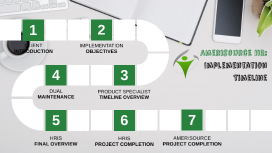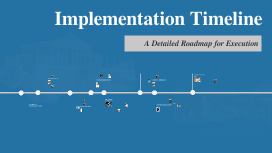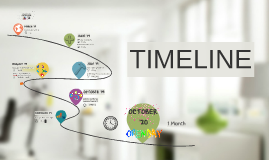Implementation Timeline
Transcript: Implementation Timeline A Detailed Roadmap for Execution Milestone Timeline Planning Evaluation Feedback Collection Conclusion and Next Steps Planning in the pre-implementation phase involves outlining project goals, defining tasks, setting timelines, and allocating resources effectively. A well-structured plan ensures alignment with project objectives and facilitates smooth execution. A Milestone Timeline highlights key project milestones and events along a chronological scale. It provides a visual roadmap of major achievements, deadlines, and important stages in the project's lifecycle, aiding in tracking progress and ensuring alignment with project goals. Evaluation in the post-implementation phase includes reviewing project performance, analyzing results against set goals, and identifying areas for enhancement. Effective evaluation enables organizations to measure the success of the project and identify areas for improvement in future endeavors. Feedback collection is a crucial aspect of the post-implementation phase, as it involves gathering input from stakeholders, team members, and end-users to gain insights into their experiences and perspectives. Constructive feedback provides valuable information for refining processes, addressing concerns, and enhancing future project implementations. Resource Allocation Pre-Implementation Phase Summary Gantt Chart Resource allocation is a critical aspect of the pre-implementation phase, involving the distribution of personnel, budget, and materials to support project activities. Efficient resource allocation enhances productivity and maximizes the utilization of available resources. Timeline Visualization Post-Implementation Phase The conclusion summarizes the key findings and outcomes of the implementation timeline, highlighting successes, challenges, and lessons learned. It sets the stage for future planning by outlining next steps and strategies for continuous improvement in project execution. A concise summary provides a snapshot of the project journey, including achievements, setbacks, and overall progress. It serves as a reference point for stakeholders and team members to reflect on the project's evolution and outcomes. A Gantt Chart is a visual representation of a project schedule that shows tasks, timelines, dependencies, and progress. It helps project managers and team members understand the project's status at a glance, enabling better coordination and decision-making. The Pre-Implementation Phase encompasses crucial preparatory steps before initiating the project execution. It involves detailed planning, resource allocation, and engagement with key stakeholders to set the foundation for a successful implementation process. Future Planning Stakeholder Engagement Utilizing visualizations like Gantt Charts and Milestone Timelines is crucial for presenting and tracking the project's progress. These graphical representations offer a clear overview of tasks, timelines, and dependencies, aiding in effective project management. The Post-Implementation Phase involves evaluating the outcomes of the project implementation and collecting feedback to assess its impact. This phase focuses on lessons learned, successes, challenges, and opportunities for future improvements. Looking ahead, future planning involves leveraging insights from the current implementation to inform strategic decisions and mitigate risks in upcoming projects. It fosters a culture of continuous improvement and innovation in project management practices. Engaging stakeholders in the pre-implementation phase is essential for obtaining buy-in, gathering feedback, and addressing concerns. Effective communication and collaboration with stakeholders foster a supportive environment and enhance the likelihood of project success. Successes Monitoring Progress Purpose Milestones and Checkpoints Monitoring progress during the implementation phase entails tracking key performance indicators, assessing milestones, and identifying potential deviations from the project plan. Regular progress monitoring allows for timely adjustments and ensures alignment with project goals. Identifying and celebrating successes is essential for morale and motivation. Acknowledging achievements not only boosts team morale but also reinforces positive practices and strategies that contributed to project success. The primary goal of the Implementation Timeline is to establish a clear sequence of tasks and milestones, ensuring efficient and effective project management. It aids in coordinating efforts, tracking progress, and maintaining accountability throughout the implementation process. Problem-solving Key Milestones Challenges Problem-solving in the implementation phase involves identifying issues, analyzing root causes, and implementing solutions to overcome challenges. Effective problem-solving skills are crucial for addressing obstacles that may arise during project execution and maintaining project momentum. Lessons

















